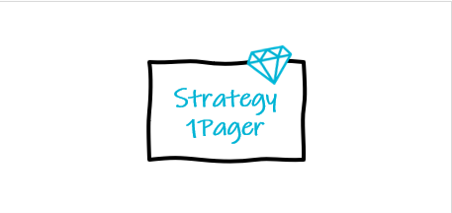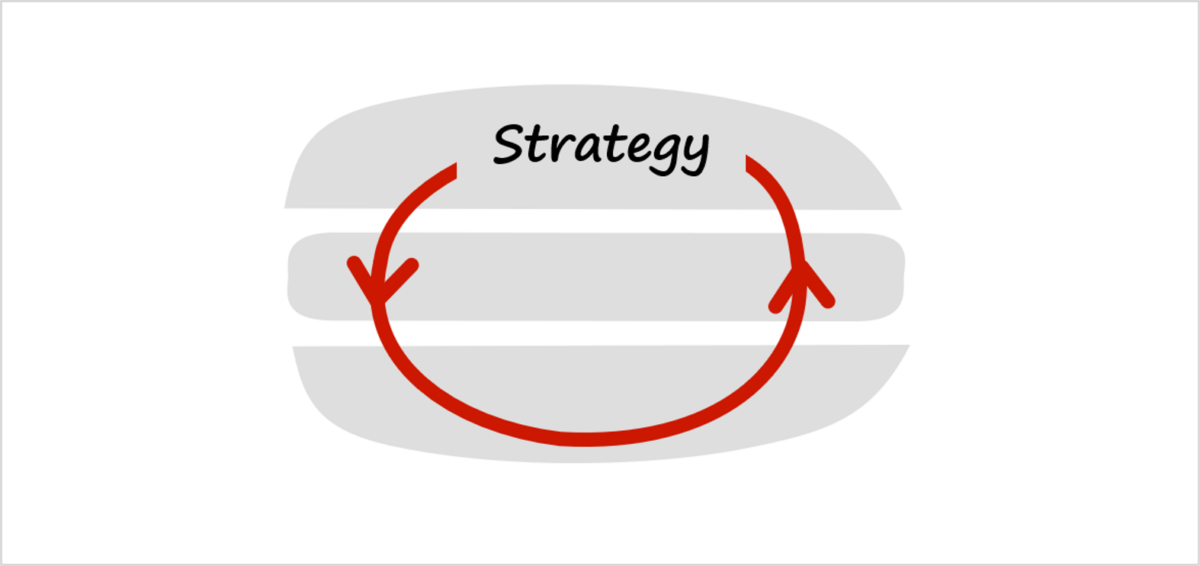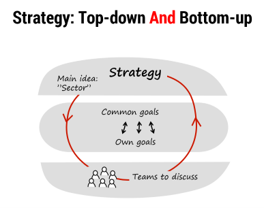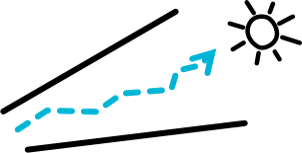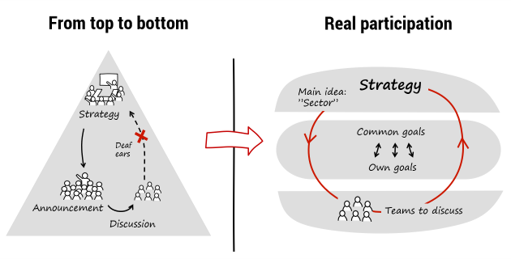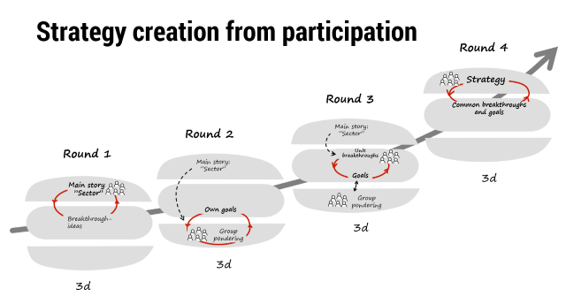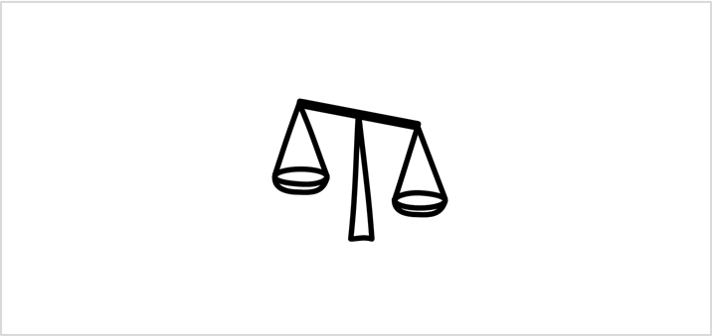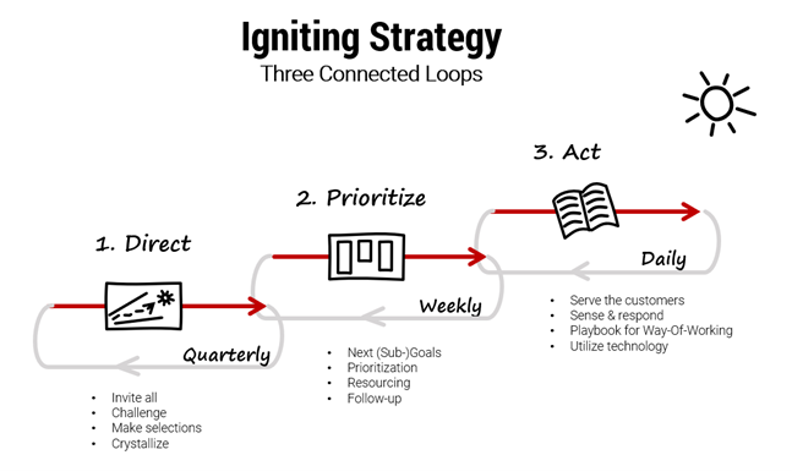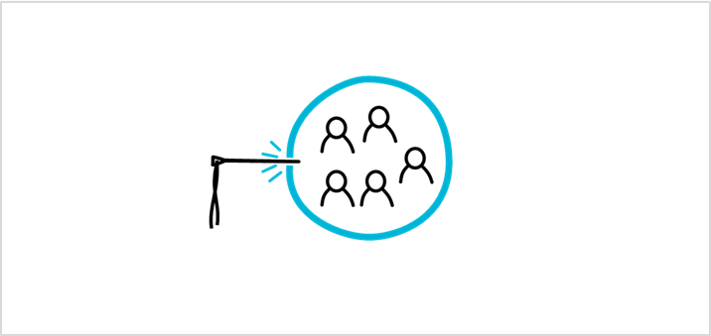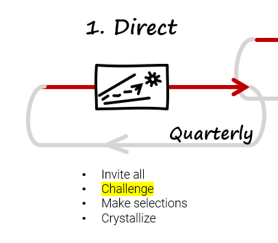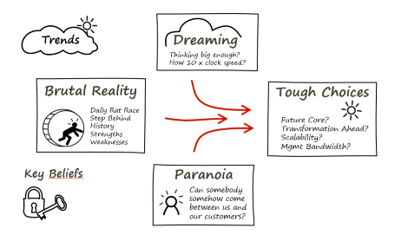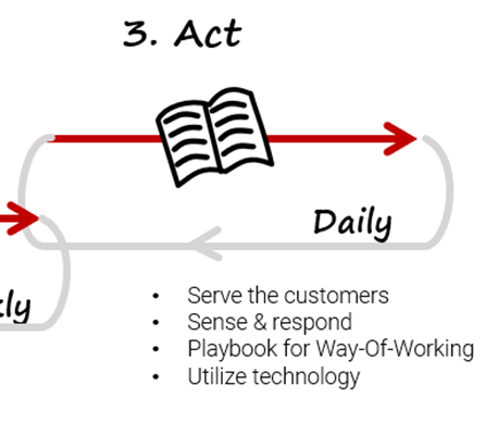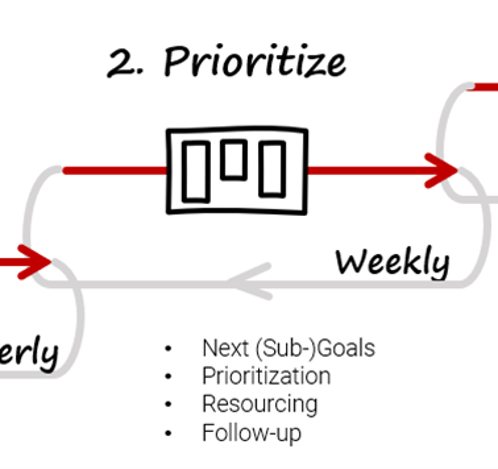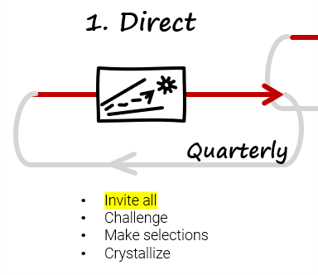
How to crystallize a strategy? – The Strategy 1Pager | 1.11
Markus Westerlund
Share this blog
Today I’m talking about crystallizing a strategy. I will explain how a strategy is simplified and goals are clarified. I will also introduce my pride, the Strategy 1Pager, which allows the whole strategy to be crystallized onto a single page.
Let’s look at our loops once again.
A strategy journey has three phases, which I call loops. The first loop consists of renewing and directing the strategy. The second loop leads the implementation of the strategy, and it is linked to the first loop. If the implementation doesn’t happen, the whole strategy is pointless. The third loop is daily operative work.
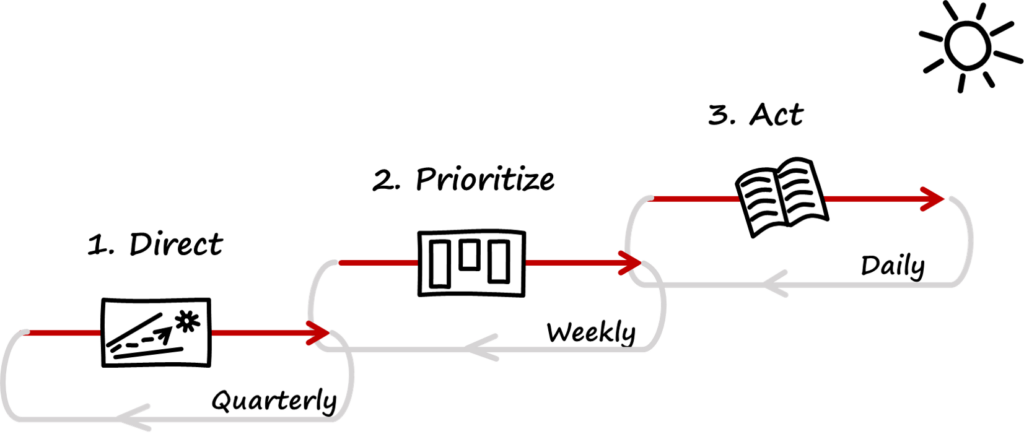
The first loop rotates quarterly. A bigger strategy round is done every now and then, however, the goals need to be updated more frequently. Have our goals been set? Do they need to be changed? How are we doing?
The second loop is about steering the strategy implementation, and it rotates weekly. What are the sub-goals and their functions? We prioritize and assign resources.
The third loop is all about implementation, and it rotates daily.
The three loops are linked together, and they rotate at different speeds. This is the whole strategy journey. It is very easy to think that the strategy process means strategic planning, the moment when the strategy is decided, and it is written down. However, in the above model this is only represented by the first loop. There are two other loops! This means that it’s better to understand the strategy journey as three full loops, not one.
Let’s focus on creating the strategy, which is the first loop. Often the end result of the strategy process is a thick pile of PowerPoint slides, and usually the contents on the slides are of very fine quality. But how well do people remember what is written on the slides? Can the strategy be crystallized and compressed into a tighter package?
Incredibly great strategy

Our company was born out of this idea. We at Stradigo concluded that strategies are incredibly finely made documents, so finely made that nobody can, in fact, implement them successfully. We felt that we need to help humankind by simplifying this.
When working with new customers I often get to have a look at their previous strategies. One time I was handed a 157-page presentation that was done the year before. It was so incredibly fine that as I browsed through it I thought to myself:
“OH MY GOD. What do these people even need me for?”
After I was over my shock, I realized that something has to be wrong if the presentation loses the train of thought constantly. According to the organization they had used old slide layouts, imported from previous companies. The quantity of the pages was blinding at first, but they ended up having clear problems in their strategy. This organization had predicted massive growth, however, nothing happened in the next four years, except that their profitability plummeted.
The strategy was wrong or too fine to be implemented. The layout was splendid, but when people tried to get the hang of it, it only made them sweat. The organization was left wondering if they would ever manage to implement it.
Strategy sales for the team
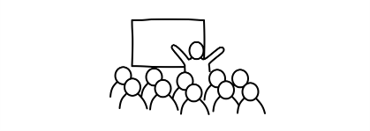
When a fine strategy is made in a conference room, the next step is to sell the idea to the staff. It begins with a large meeting where the CEO presents the strategy over an hour or two. People are extremely interested in listening, because they want to know how to continue into the future.
After the presentation comes the Q&A session, where someone raises their hand and, interestingly enough, always asks the same question:
“What does this mean in practice?”
The CEO has to give an example, but the thing is that these people should themselves figure out what it is in practice. I’ve talked about this before.
The reality
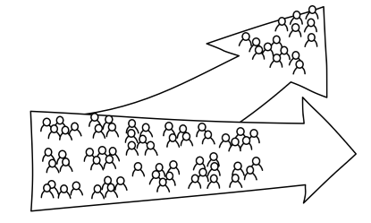
The reality, however, is often this. The board and management group have sat down for many workshops. They have crystallized a hard thing and found the catch, and they are very excited. Then this is explained to the others, but none of them really knows what to do in practice.
This is a HUGE problem. If the strategy isn’t implemented, what’s the use of it? All the work, money and energy has gone to waste. It’s devastating!
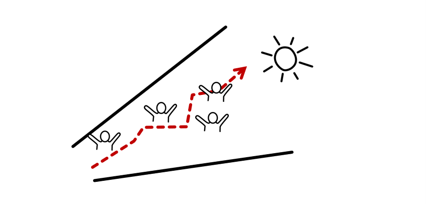
Alternatively, one can ignite the strategy. Business owners get to decide the cornerstones and the direction they want to go in. They want to risk their money in some business and then say: “Please don’t go overboard.” Then they hire professionals that are interested in the company’s sun, the purpose for their customers.
The job is to find the best way to the sun. How do we help our customers? They have to be sailing every day, so to speak. They need to know the strategy so that they can sail towards the sun. We need a crystallized strategy, with simple enough frames. That is why we need the following.
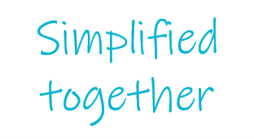
We need to simplify and demystify by crystallizing the strategy. I’ve been terrified while reading what some American professors write about strategy. The text is so difficult to understand, my goodness!
The other keyword is “together”. Simplify Together.
It’s all possible now thanks to technology, that multiplies efficiency, so it’s not time-consuming.
I just finished a strategy process for a billion-dollar company. We held three meetings with the entire staff. Have a guess how long the whole process took. The whole staff worked four hours and the workshop participants 15 hours altogether. That’s two and a half days to create a strategy.
Would you sacrifice four hours of work to be able to create a massive amount of energy that spurs people forward? Somehow it seems stupid not to do things this way.
We do it together!
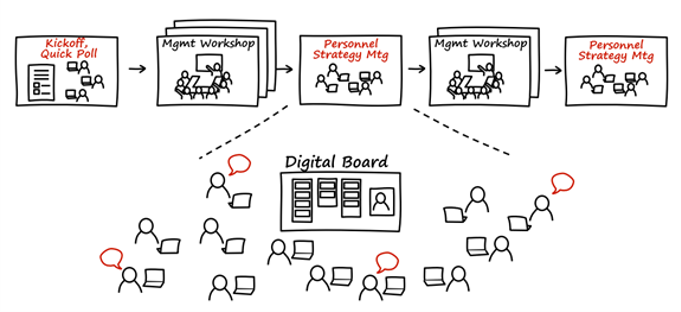
Let’s do things authentically together from the start! The first one-hour kickoff is held online with the whole group. After that there are workshops, which anyone can volunteer to attend. The volunteers sign up on a Trello board, and a group is formed! It’s also so wonderful to see young people take part in a strategy for the first time.
The staff meetings and workshops alternate in turns. Every meeting has its own digital board that enables everyone to write on cards. They’re like sticky notes, but digital and better. We use Trello for this.
People have their video cameras on during meetings, so they can all talk and write simultaneously on the board. With one click everyone can be sorted into break-out rooms, where they can converse in small groups. Finally, they write their conclusions on the digital cards.
Crystallizing a strategy onto a single page
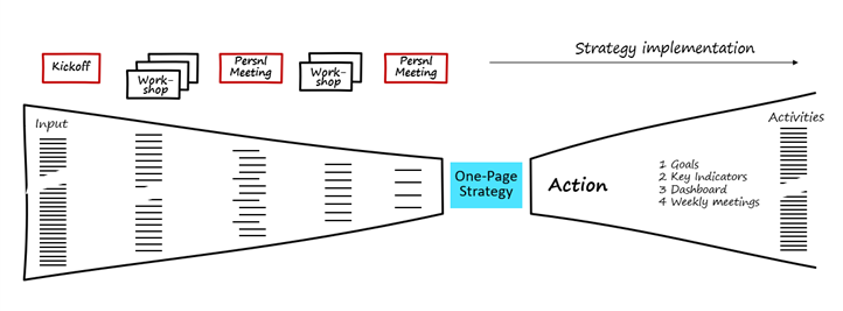
We often have three workshops and two staff meetings. No more two-day or even one-day sessions. No more travelling and polluting, no traffic jams, no wasting time! Let’s work from our current location.
Don’t sit in the conference room together! If some are sitting in a conference room and the rest are taking part online, the people in the room will converse with each other and the other half online won’t be able to catch what they’re saying.
No no no. INVOLVE EVERYONE! One can participate through phone nowadays. Earphones in and let’s go!
The strategy funnel
As you can see from the image above, the number of comments, represented by thin lines, is great. All of them are crystallized and compressed. They are prioritized, meeting by meeting, and only the top candidates make the cut. By working digitally, comments are always written down, which means everything gets documented at the same time.
No more colorful walls stacked full of sticky notes, which are transcribed into a file after a few days. Digital cards, on the other hand, can be zoomed in and the best ones can be voted with likes. The staff is then shown all that has happened in between the workshops.
The billion-dollar company strategy meeting collected 4080 written comments! The deciding factor is how they are crystallized. These 4080 comments were crystallized into 177 topics that were prioritized and they made the cut. Out of 177 cards the main themes and their focus areas were found. The whole process is absolutely solid! It, of course, requires some know-how have the energy to prioritize these comments, because nothing can be forgotten!
The company board gave a comment:
“But those people don’t know how to think about the future, they can only think operatively.”
It depends of course what kind of task one gives them! We dream in workshops and travel to the future with a time machine and choose trends.
We also think about paranoia and about what our competitors are doing. What enemy lives in us? How can we screw up this whole process? How do we turn the screw-up into a victory? What NOT to do?
These are the things that produced the 4080 comments, which were prioritized into 177 topics. Those were then compressed onto a Strategy 1Pager. It had a lot of things for the future. It’s somehow funny that in bigger companies the board and management group think they have some kind of a monopoly to understand the future.
The future doesn’t exist
I’ve mentioned the Swedish futurologist Kjell A. Nordström before. He once began a presentation with these words: “The future cannot be studied because it doesn’t exist.”
This reminds me of the words ‘intuition’ and ‘gut feeling’, and how it has become an annoying label today. You know what? The finest computer in the entire world is between one’s ears. If an expert gives their vision as to where the world is going, it is better to hear it from an expert than an amateur. It’s the expert’s point of view, but then here comes the criticism like this expert view is such a bad thing.
It’s based on a mathematical scientific paradigm, where the truth is only measured outside one’s head. But that’s measuring the past. Then one is not measuring the future, but only what is now.
All statistics can be utilized to see if the curve is going straight, up or down. The trends are visible, but no-one knows the future. A good vision, assumption or belief is worth gold.
All numbers are only guesses, because the future doesn’t exist. That’s why we need a vision where the business will succeed. Then we have key beliefs and assumptions about what’s going to happen. The strategy is built on top of those key beliefs.
If the beliefs are high-quality, the strategy will be high-quality. If the beliefs are not high-quality, meaning false, the strategy will be bad.
Beliefs and key assumptions aren’t usually even written down. They exist in the speeches of board meetings. The CEO holds a briefing about this meeting and the management group begins to work on the next strategy.
A one-page strategy
Finally, when the strategy process is completed, crystallize it into a single page. It’s boiled down like a sauce. That’s when the big tough choices emerge. They have to be so tough that someone becomes anxious. If no-one becomes anxious, nothing changes! Because we want to steer the operation towards a better future, of course some things need to be terminated if they are outdated.
Think, a big company strategy can be done in just over two days! It’s absolutely amazing.
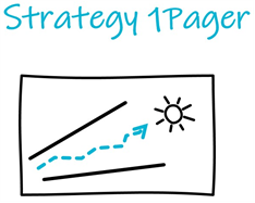
The whole point of this text is to crystallize a strategy onto a Strategy 1Pager. Once you have that, you know what to do. A strategy is of course based on beliefs: Bad belief → Bad strategy. Good belief → Good strategy.
The talent is to take all visions inside the organization and compress them onto one page. The page needs to have those big tough choices written down, and there must not be too many!
The catch is to have the talent to do a Strategy 1Pager. The strategy becomes simple and bloody exciting.
Ignite your strategy by crystallizing your strategy! Read more.🔥
Recent Posts
Stradigo
Stradigo is a brand owned by Rdigo Oy (Business-ID: 2120844-1).
Learn more from our Imprint.
Rdigo Oy is registered in Finland as a Limited company. We are a strategy consultancy located in the Helsinki capital region.
We’ve been in business since 2007. The company name comes from the latin word Redigo, meaning both ‘I shape’ & ‘I renew’.
Stradigo combines the word strategy with Rdigo.
